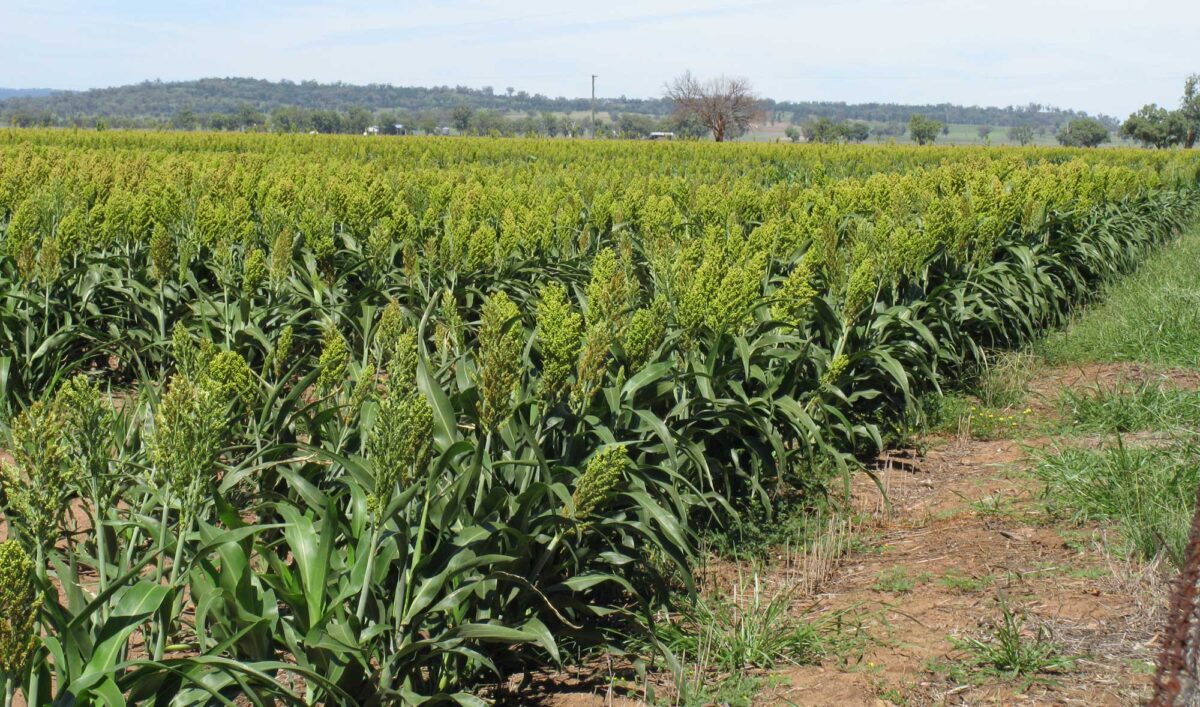Page snapshot: Introduction to the structure of the sorghum plant, including the morphology (form) and anatomy (internal structure) of stems, roots, and leaves. Also covers the organization of the reproductive structures.
Topics covered on this page: Introduction; Stems; Roots; Leaves; Leaf morphology; Leaf anatomy; Reproductive structures; Inflorescences, spikelets, and florets; Fruits; Resources.
Credits: Funded by the National Science Foundation. Any opinions, findings, and conclusions or recommendations expressed in this material are those of the author(s) and do not necessarily reflect the views of the National Science Foundation. Page by Elizabeth J. Hermsen (2022-2023).
Updates: Page last updated January 31, 2023.
Image above: Field of sorghum (Sorghum bicolor), New South Wales, Australia. Photo by Harry Rose (flickr, Creative Commons Attribution 2.0 Generic license, image cropped and resized).
Introduction
The purpose of this page is to introduce the basic structure of the cultivated sorghum plant (Sorghum bicolor). Generally speaking, sorghum is organized like other grasses in tribe Andropogoneae (the Bluestem or Sorghum Tribe), except that it has been modified by the process of domestication. The ways in which it has been modified vary according to the variety of sorghum. Generally, domesticated sorghums have tall, thick, unbranched culms (stalks), inflorescences that do not break apart when mature, and relatively large grains (although still smaller than some other cereal crops).

Photograph of a mature sorghum (Sorghum bicolor) plant, labeled. Photo by ABHIJEET (Wikimedia Commons, Creative Commons Attribution-ShareAlike 3.0 Unported license, image cropped, resized, labeled).
Stems
Cultivated sorghum has a single thick stalk or culm that ends in an inflorescence; the length of the culm varies, but grain crops may reach about 3 feet (1 meter) whereas biomass types may reach 20 feet (more than 6 meters). The culm bears about 15 to 17 leaves, depending on the type of sorghum. Unlike in many other grasses, the interior of a sorghum stem is solid in both nodal and internodal regions.
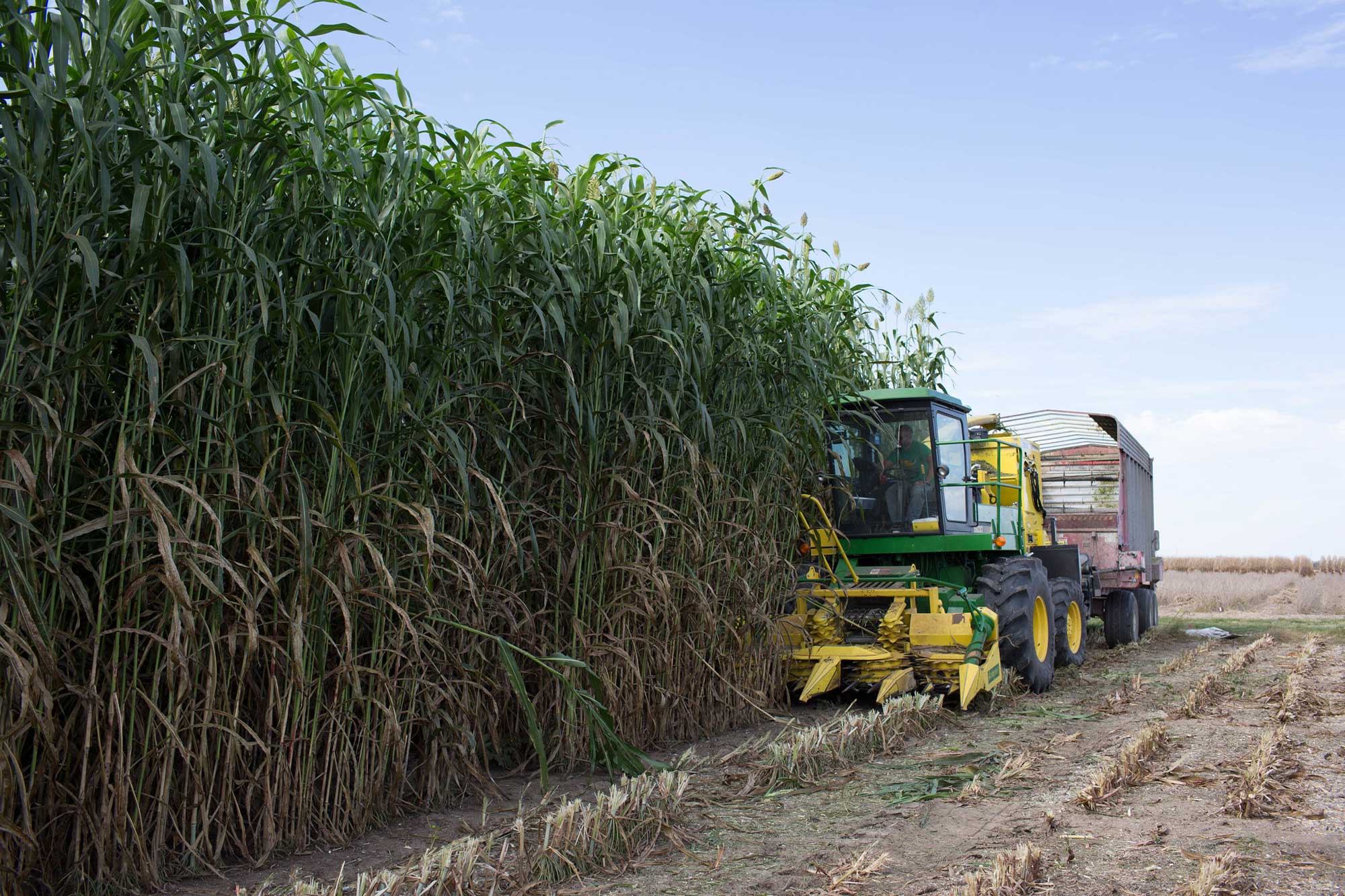
Tall sorghum plants cultivated for biofuel being machine-harvested. Photo by Claire Benjamin (PETROSS, TERRA-MEPP & WEST on flickr, Creative Commons Attribution 2.0 Generic license, image resized).

Cross sections of stems of different varieties of sorghum (Sorghum bicolor) in the internodal regions. Scale bars = 0.5 cm. Source: Modified from figure 1 in Zhang et al. (2018) The Plant Cell 30: 2286-2307 (Creative Commons Attribution 4.0 International license, image cropped).
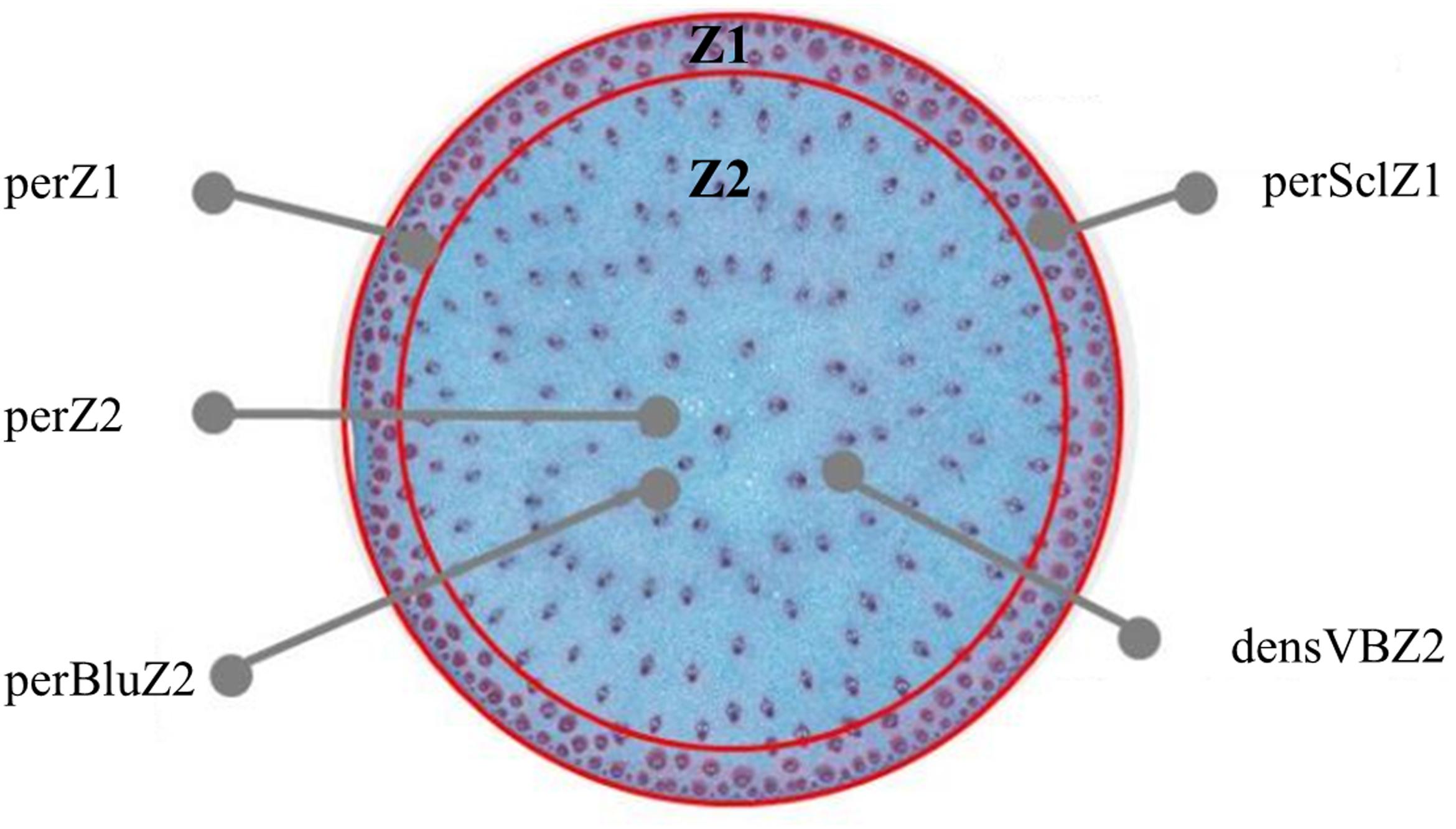
Stained cross section of a sorghum (Sorghum bicolor) stem in an internodal region, showing vascular bundles (dark dots) scattered throughout the stem tissue. This image has been labeled with different regions that were used in a study. Source. Figure 1 from Perrier et al. (2017) Frontiers in Plant Science 8: 1516 (Creative Commons Attribution 4.0 International license).
Roots
The root system of sorghum is similar in organization and development to the root system of maize (Zea mays). The first root, or primary root develops from the radicle (embryonic root) of the embryo. Shortly after the primary root begins elongating, seminal roots (seed roots) also develop from the embryo, emerging from the region above the radicle (primary root). The primary and seminal roots are temporary, eventually dying as their function is taken over by adventitious roots that develop from the stem.
Sorghum develops two types of stem-borne roots. Some adventitious roots develop near the base of the stem and are completely underground. Prop roots or brace roots begin development aboveground and grow into the soil. Prop roots help to support the aerial part of the plant; the aboveground parts of prop roots are green and carry out photosynthesis.
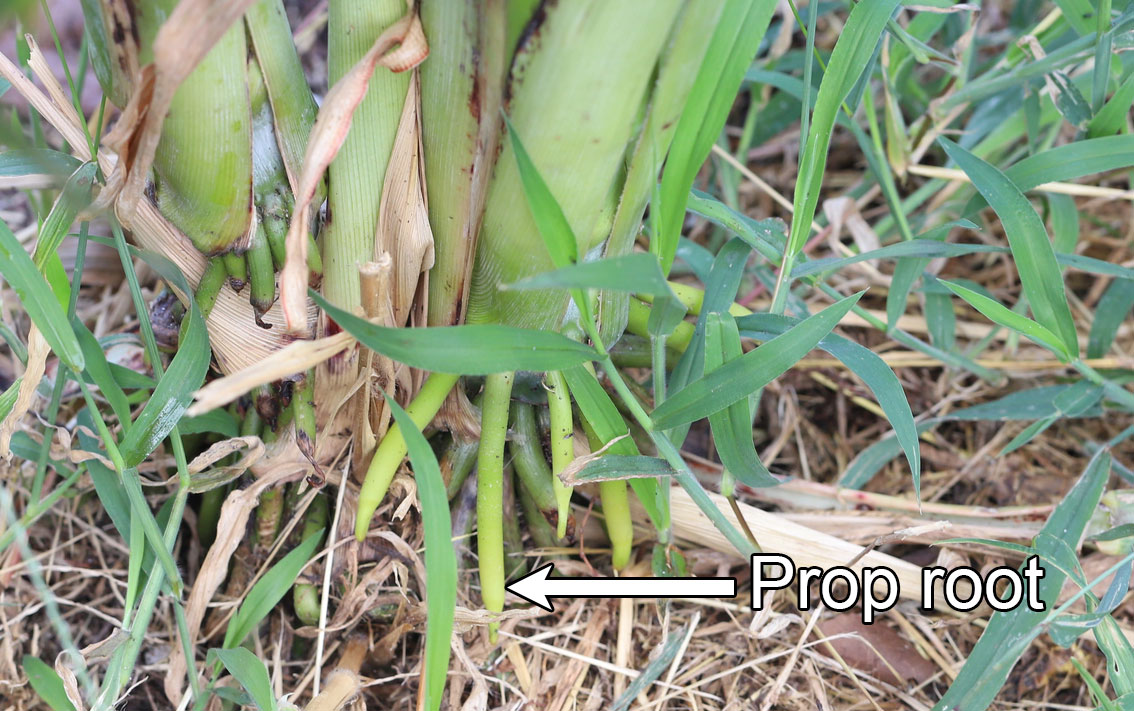
Sorghum (Sorghum bicolor) prop or brace roots. Photo by Steven Bozdin (iNaturalist, Creative Commons Attribution 4.0 International license, image cropped, resized, and labeled).
Leaves
Leaf morphology
Sorghum leaves are organized like the leaves of other grasses. Each leaf consists of a sheath that wraps around the stem and an elongated blade that sticks out from the side of the stem and intercepts sunlight. The place where the sheath and the blade come together is the collar. The major leaf veins are parallel. The leaves lack auricles but have ligules. The last foliage leaf on the stem (the highest leaf) is called the flag leaf. The flag leaf is the leaf directly below the inflorescence.
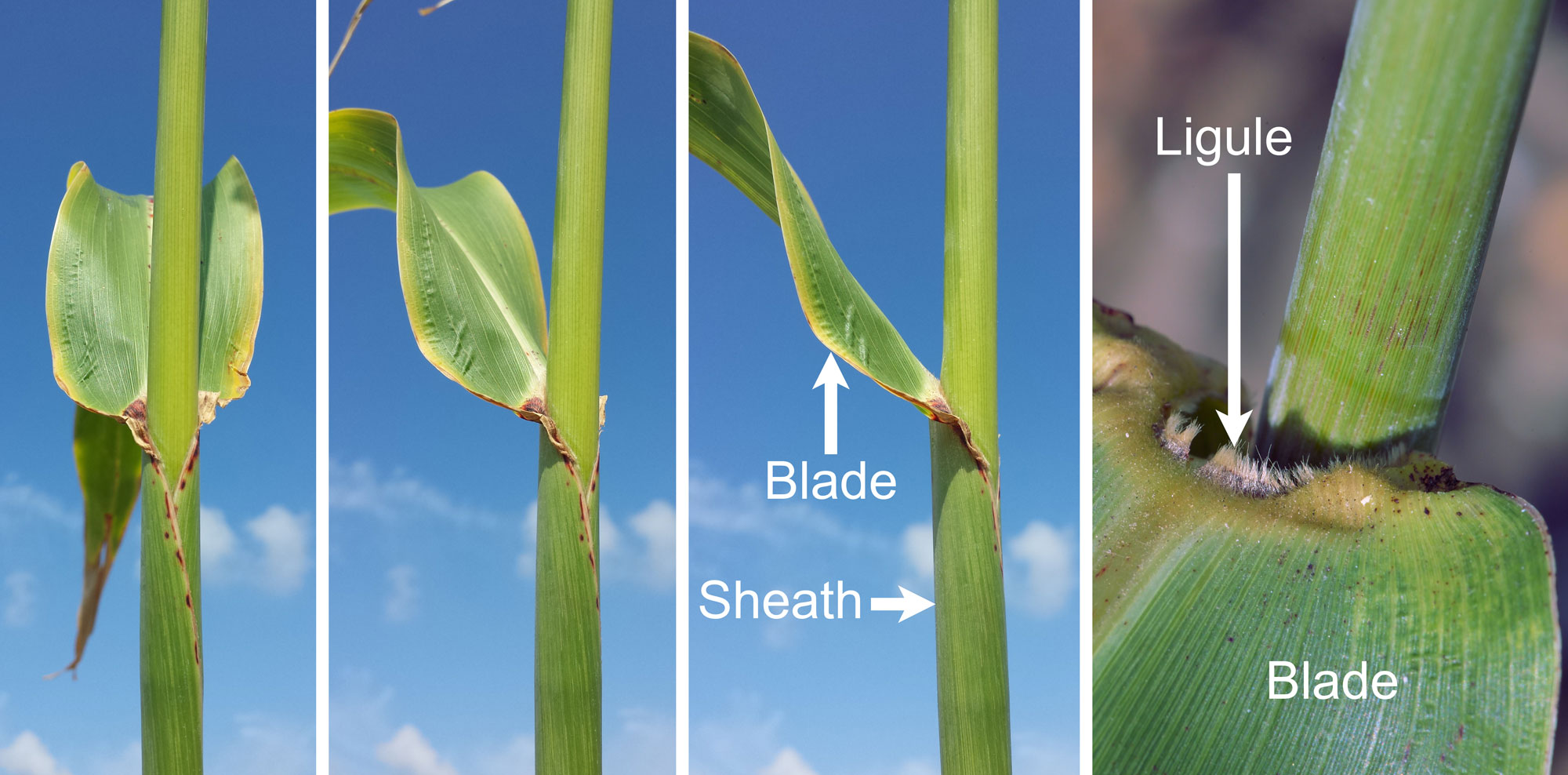
Sorghum (Sorghum bicolor) foliage leaves. Left three panels: Three different views of a leaf showing the sheath and blade. Right: Close-up of a leaf showing the ligule made up of hairs and a blade. Left photos one, two, and three by Stefan.Iefnaer (Wikimedia Commons, Creative Commons Attribution-ShareAlike 4.0 International license) and right photo by Rasbak (Wikimedia Commons, Creative Commons Attribution-ShareAlike 3.0 Unported license).
Leaf anatomy
Leaf epidermis
The epidermis of the sorghum leaf is similar to that of other grasses. It has elongated long cells and shorter short cells, which may contain cork or silica. The long cells have wavy side walls. The silica cells contain bilobate, trilobate, or cross-shaped silica bodies (phytoliths). The leaves also have prickle-like hairs that contain silica bodies. Stomata (pores) occur between some of the long cells.

Silica bodies from the epidermis of sorghum (Sorghum bicolor), from left to right: bilobate (from a short cell), elongated with wavy walls (from long cells), silica body from a hair. Source: Modified from figure 5 in Zancajo et al. (2019) Frontiers in Plant Science 10: 1571 (Creative Commons Attribution 4.0 International license, image cropped).
Leaf vascular bundles and mesophyll
Like other members of Tribe Andropogoneae, sorghum is a C4 plant. Each vascular bundle has a bundle sheath made up of one layer of cells with large chloroplasts near their outer walls. As is common in C4 plants, mesophyll cells are arranged concentrically around the bundle sheath.
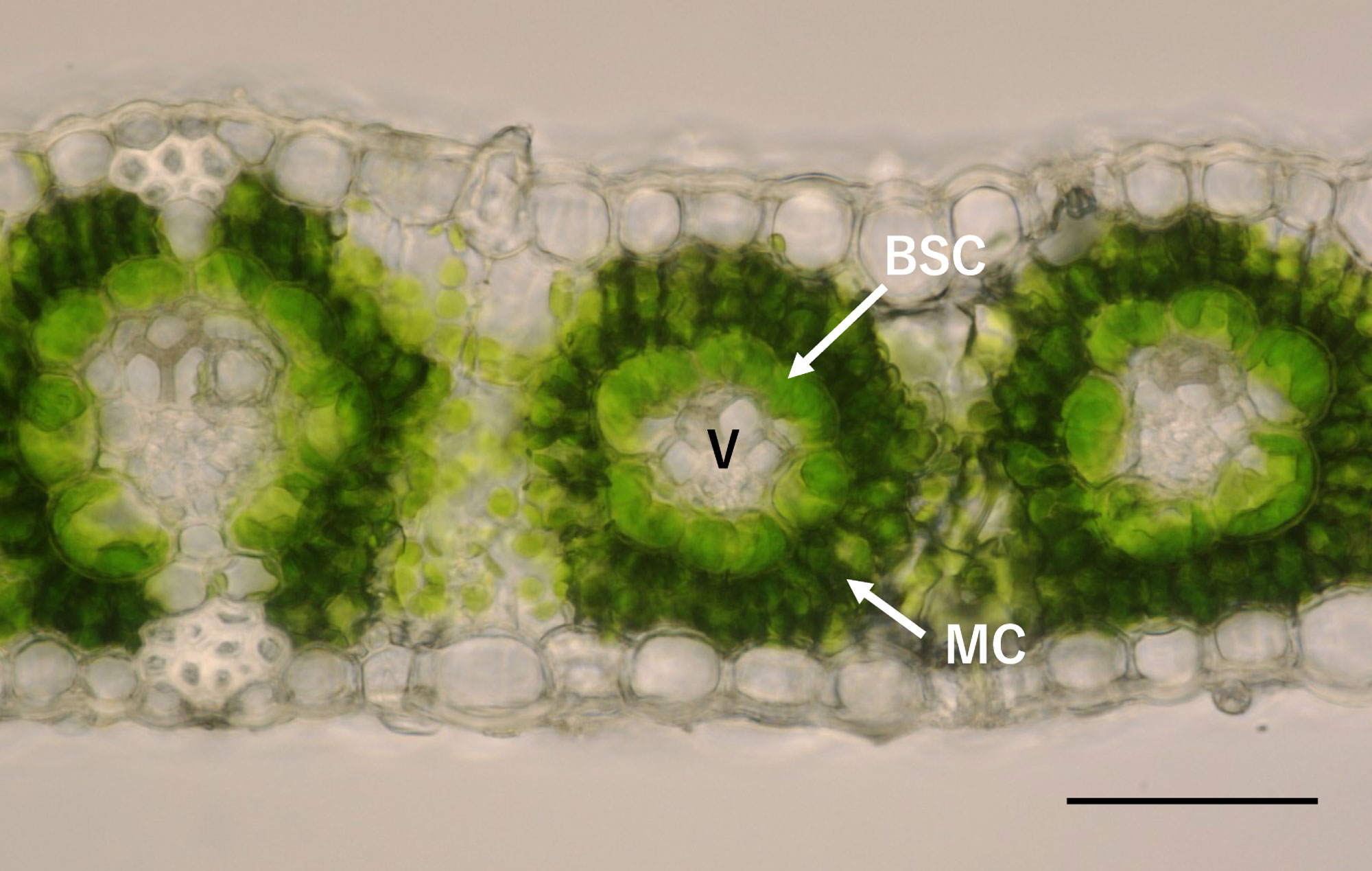
Fresh cross section of a sorghum (Sorghum bicolor) leaf showing three large vascular bundles, each encircled by a single-layered bundle sheath with cells containing chloroplasts; each bundle sheath is surrounded by mesophyll cells. Labels: V = vascular tissue, BSC = bundle sheath cells, MC = mesophyll cells. Scale bar = 50 microns (0.05 mm). Photo by Osamu Ueno and Yuhei Fuchikami (figshare, Creative Commons Attribution 4.0 International license, image cropped and resized).
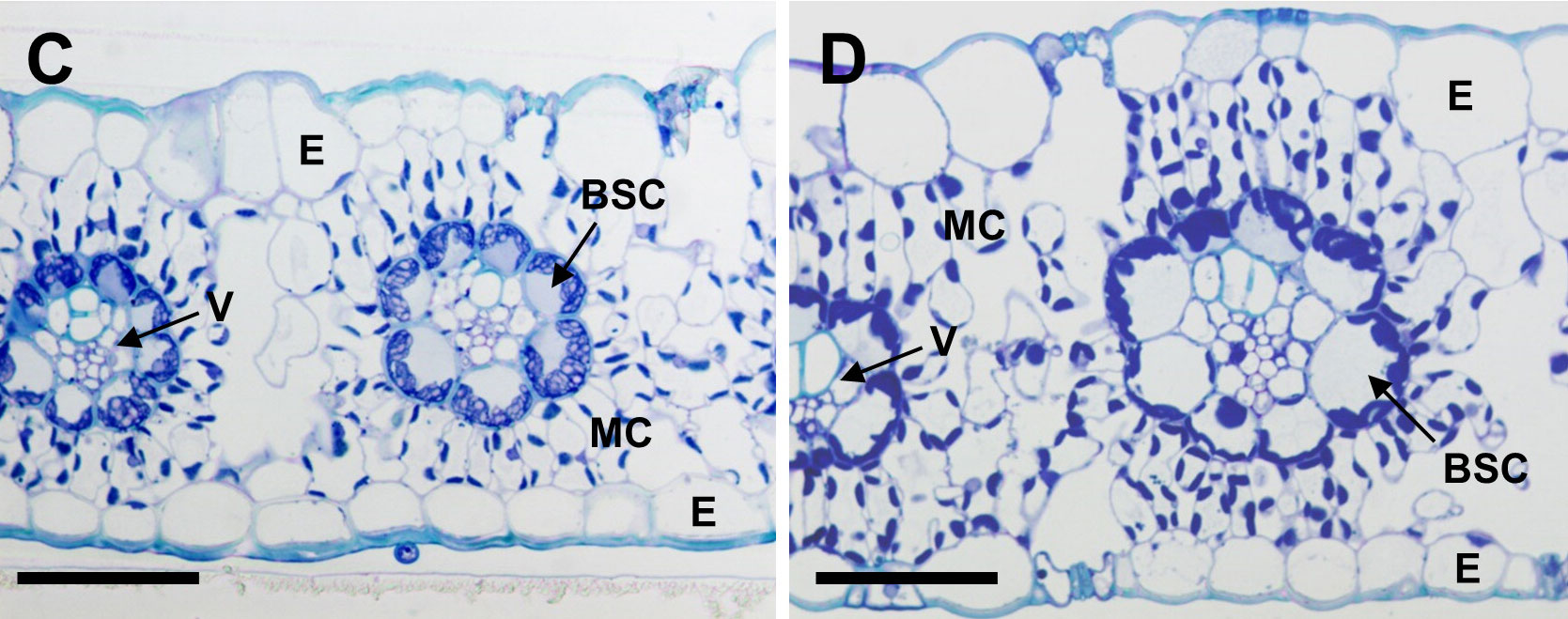
Fixed and stained cross sections of leaves of sorghum (Sorghum bicolor) showing vascular bundles, each encircled by a single-layered bundle sheath with cells containing chloroplasts (blue dots) along their outer walls; each bundle sheath is surrounded by mesophyll cells. Labels: E = epidermis, V = vascular tissue, BSC = bundle sheath cells, MC = mesophyll cells. The two leaves in this photo were used in a study where they were grown in soils with different levels of nitrogen; the plant on the left (C) received less nitrogen, the plant on the right (D) received more. Scale bars = 50 microns (0.05 mm). Source: Modified from figure 4 in Makino and Ueno (2018) Plant Production Science 21: 39-50 (Creative Commons Attribution 4.0 International license, image cropped).
Reproductive structures
Inflorescences, spikelets, and florets
Sorghum inflorescences are panicles. A panicle is an inflorescence with a central stem and lateral (side) branches. The lateral branches bear smaller inflorescence branches, called rames; each rame has between about two and seven groups (pairs and triplets) of spikelets. The inflorescence of cultivated sorghum varies in shape and size.
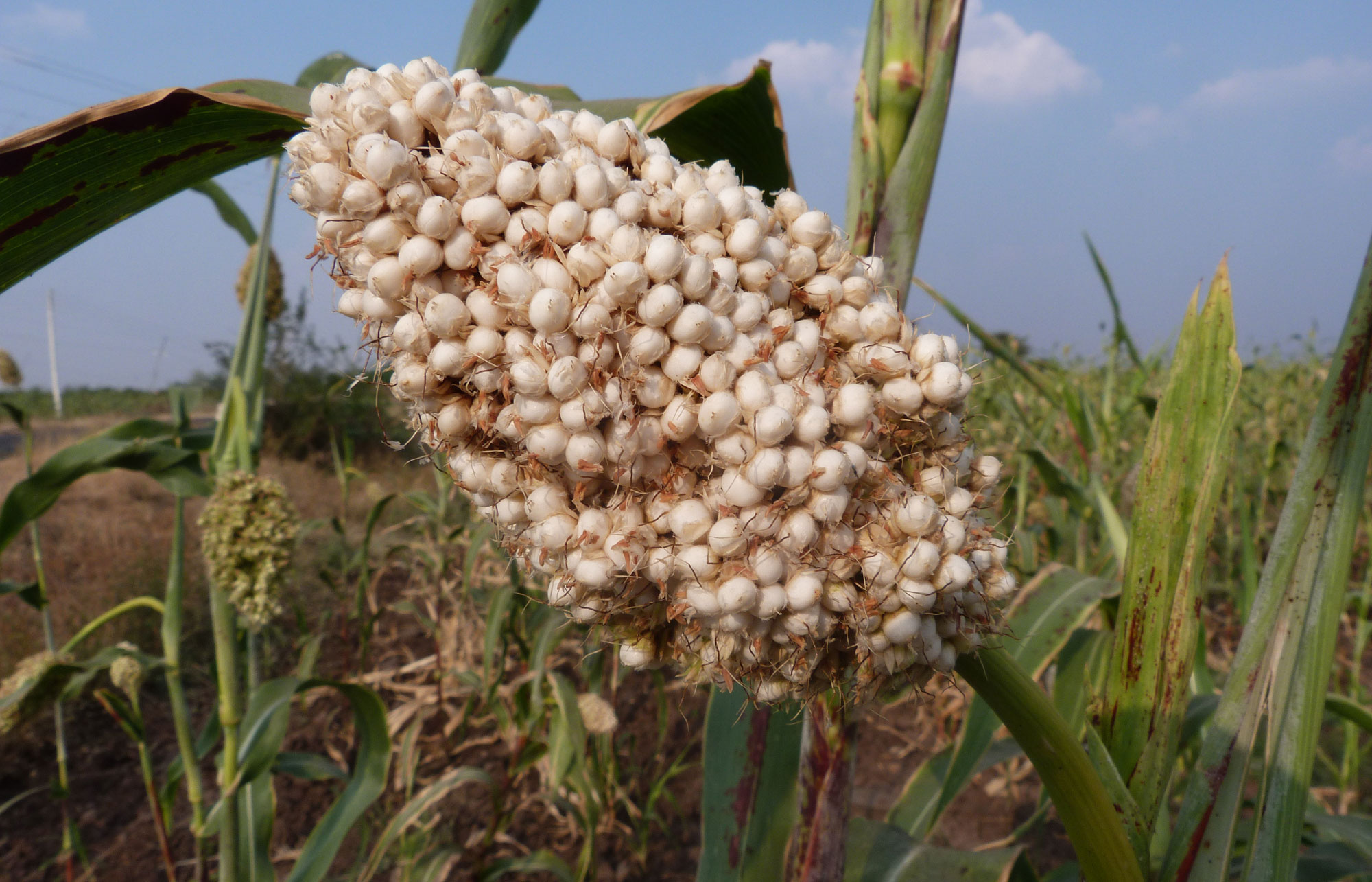
Inflorescence of cultivated sorghum or jowar (Sorghum bicolor) with mature grains, Maharashtra, India. Photo by MGB CEE (Wikimedia Commons, Creative Commons Attribution-ShareAlike 4.0 International license, image cropped and resized).
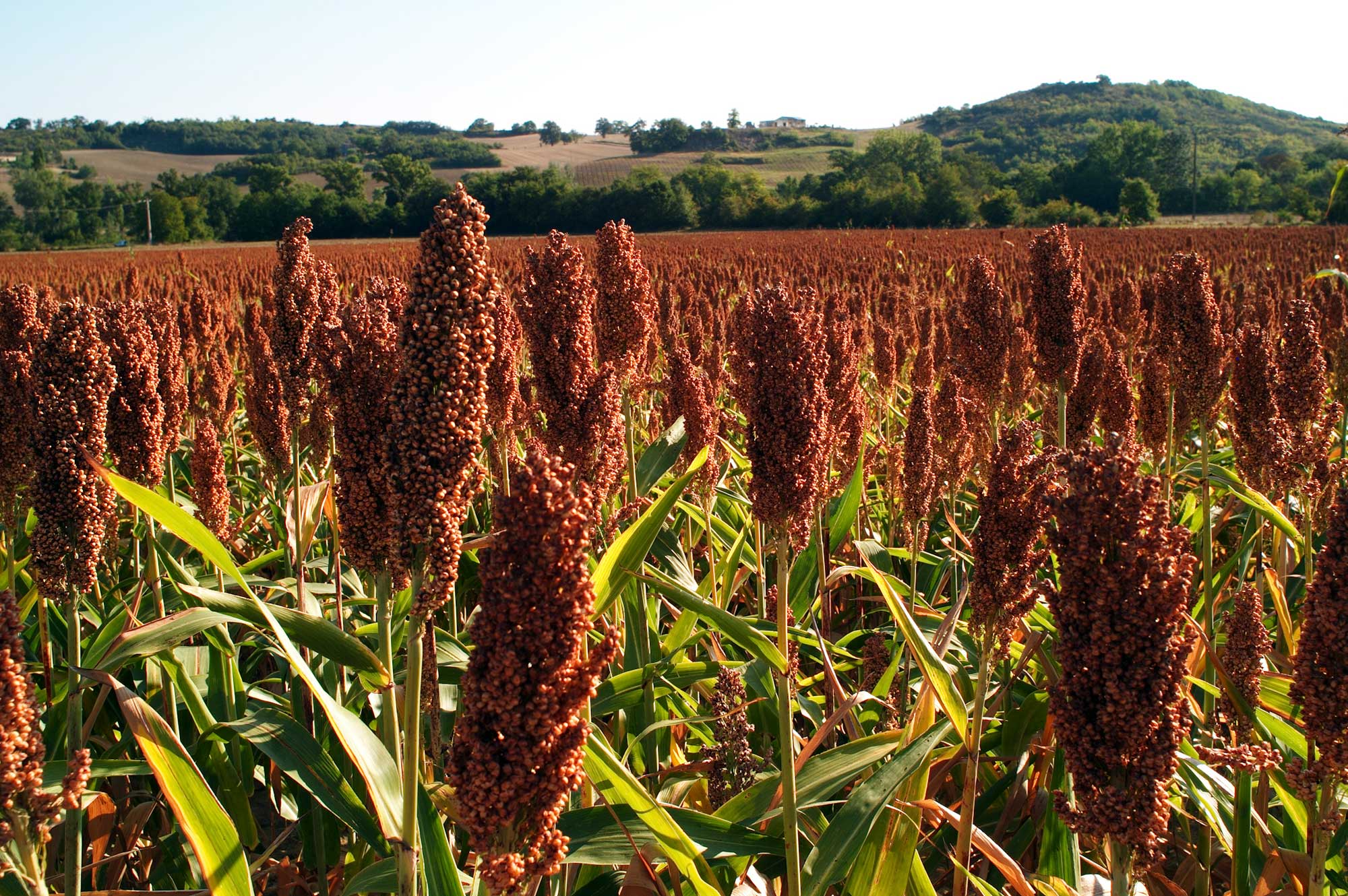
Inflorescences of cultivated sorghum (Sorghum bicolor) with mature grains, France. Photo by Jean Weber (flickr, Creative Commons Attribution 2.0 Generic license, image resized).
The spikelets in sorghum are mostly in pairs, although the spikelets at the ends of branches are in groups of three. Each spikelet pair includes one pedicellate (stalked) spikelet and one sessile (stalkless) spikelet; groups of three spikelets have one sessile and two pedicellate spikelets.
The sessile spikelets have one fertile floret. The fertile floret is bisexual, meaning that it has both stamens (male or pollen-producing structures) and a pistil (female or ovule-producing structure). The pedicellate spikelets are either sterile or fertile. If fertile, the pedicellate spikelets are male.
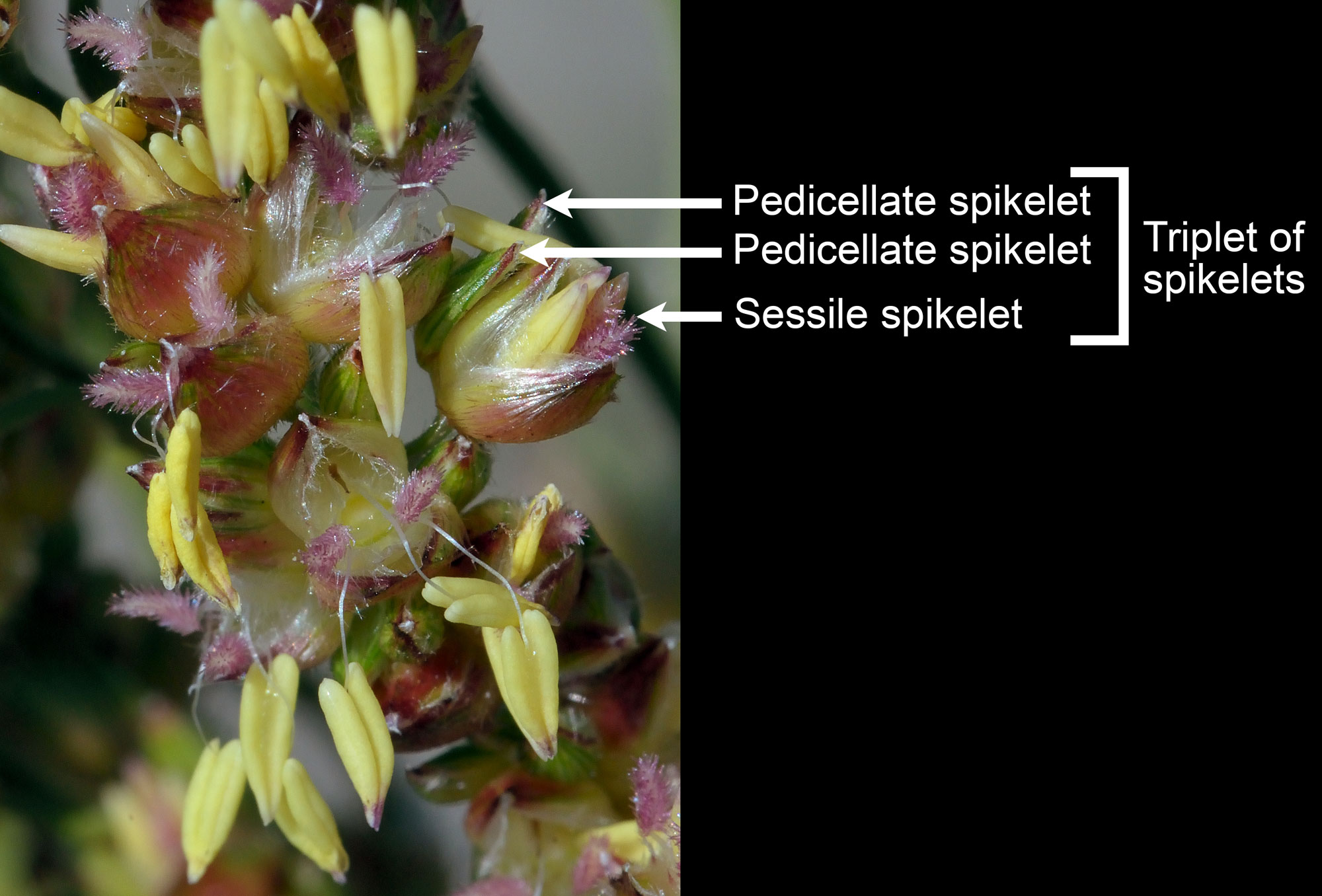
Spikelets of cultivated sorghum (Sorghum bicolor). Sorghum has sessile and pedicellate spikelets. The sessile spikelets are bisexual (male and female), whereas the pedicellate spikelets may be male or sterile. Notice the feathery purple stigmas and the yellow anthers on the bisexual florets. Photo by Rasbak (Wikimedia Commons, Creative Commons Attribution-ShareAlike 3.0 Unported license, image resized and labeled).

Sorghum (Sorghum bicolor) spikelets in two views. Sorghum has sessile and pedicellate spikelets. The sessile spikelets are bisexual (male and female), whereas the pedicellate spikelets may be male or sterile. In this example, the anthers appear to have been lost, probably because the fruits are relatively mature. Photo by Stefan.Iefnaer (Wikimedia Commons, Creative Commons Attribution-ShareAlike 4.0 International license, image resized and labeled).
Fruits
Following pollination and fertilization, the fertile bisexual florets mature into fruits. Sorghum fruits are caryopses (grains) that come in a variety of colors. Inflorescences of cultivated sorghum do not disarticulate (break apart) when they are mature. Inflorescences that do not break apart when mature are one of the common features of domesticated grasses that are grown for their grains.
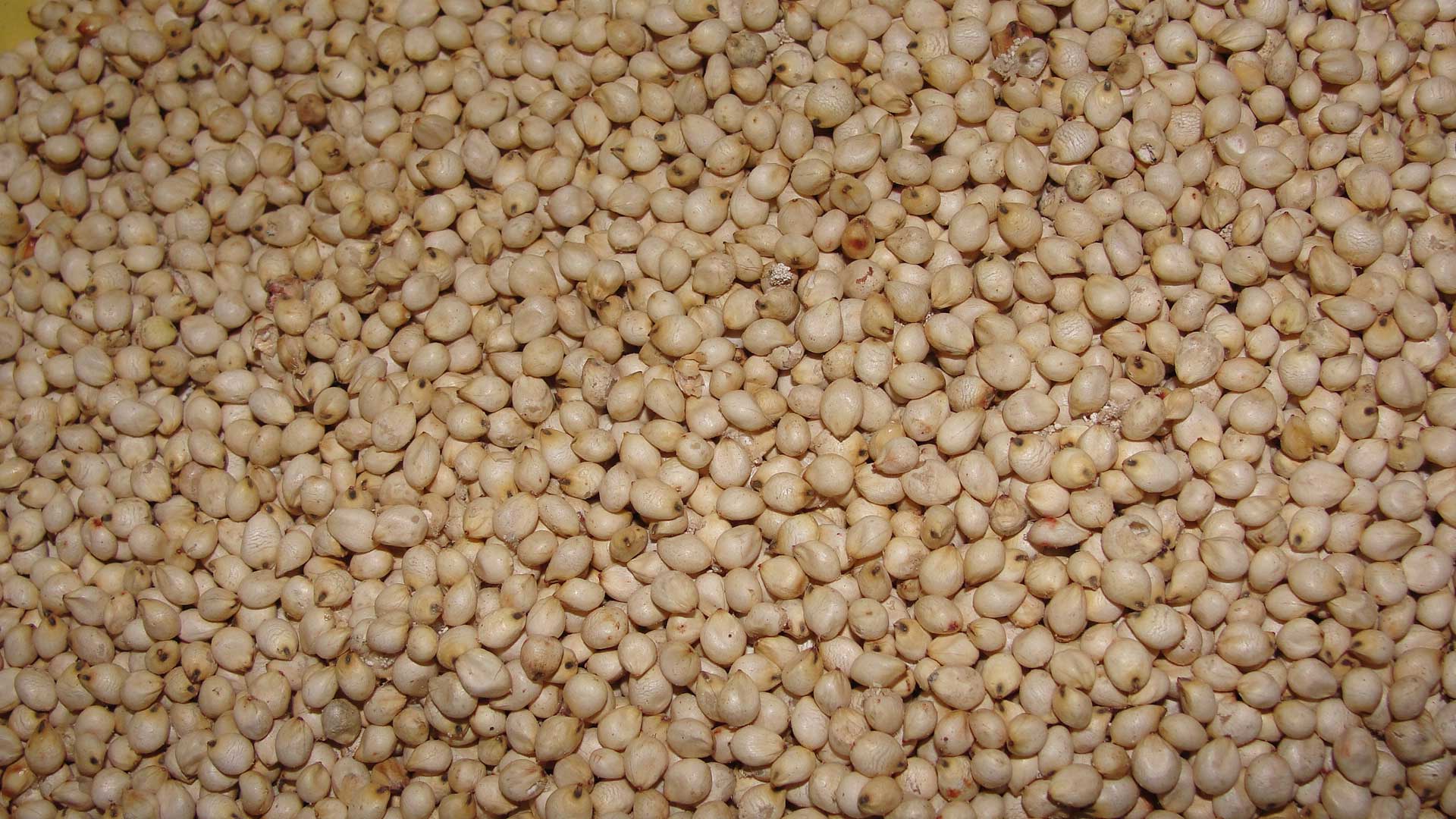
Grains of white sorghum (Sorghum bicolor). Photo by Thamizhpparithi Maari (Wikimedia Commons, Creative Commons Attribution-ShareAlike 3.0 Unported license).
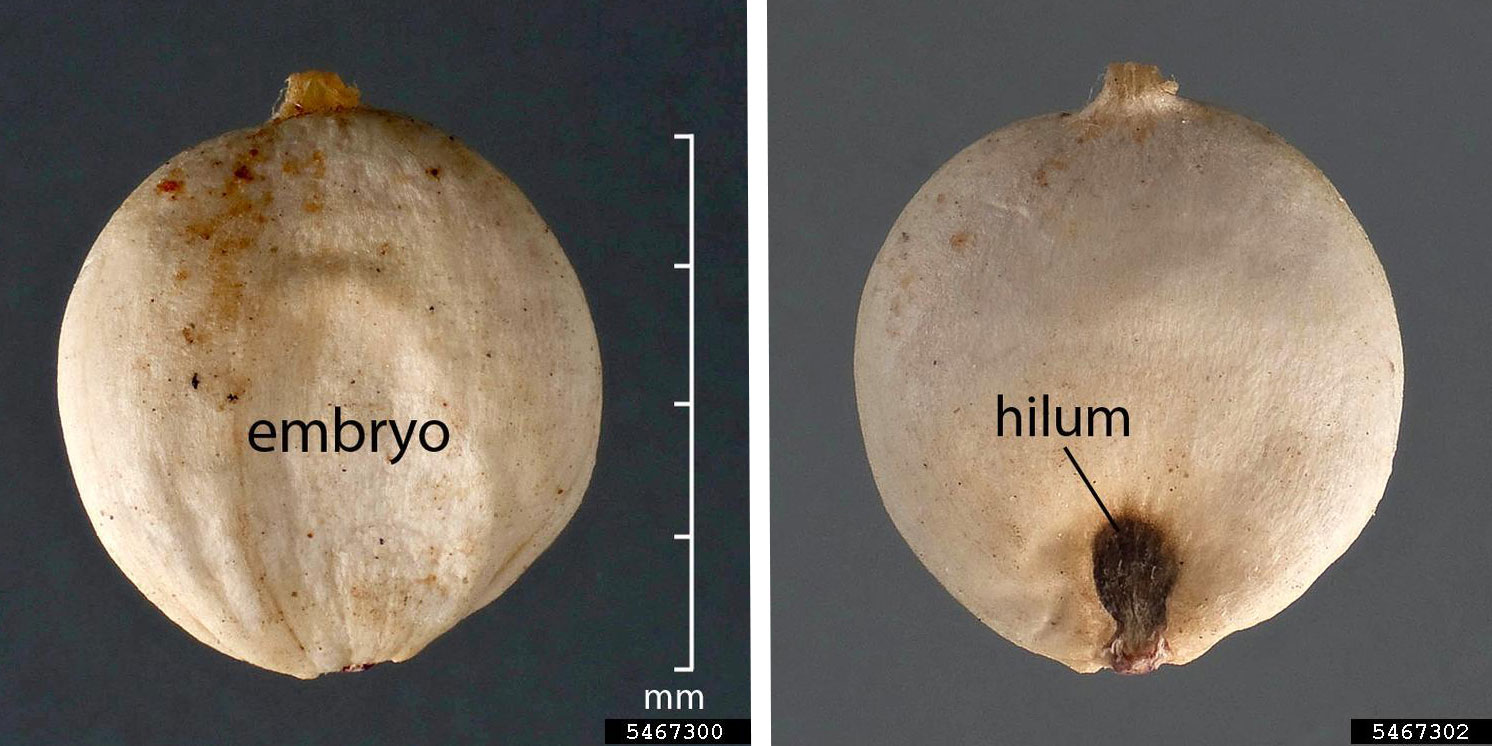
Two sides of a grain of sorghum (Sorghum bicolor). The depression on one side shows where the embryo is. The hilum on the other surface is the attachment point of the grain. Left photo and right photo by D. Walters and C. Southwick, Table Grape Weed Disseminule ID, USDA APHIS PPQ (Invasive.org, Creative Commons Attribution-NonCommercial 3.0 United States license, images cropped).
A sorghum grain consists of an embryo and endosperm, which serves as food for the embryo once it begins growing into a seedling. The outer layer of the endosperm is the aleurone layer. The embryo and endosperm are surrounded by a thin pericarp, or fruit wall.
As in other grasses, the sorghum embryo is complex. The upper end of the embryo is covered by a coleoptile, or protective sheath. The radicle (embryonic root) at the opposite end of the embryo is also protected by a sheath, the coleorhiza. A cotyledon (seed leaf) called a scutellum is attached to the embryo.
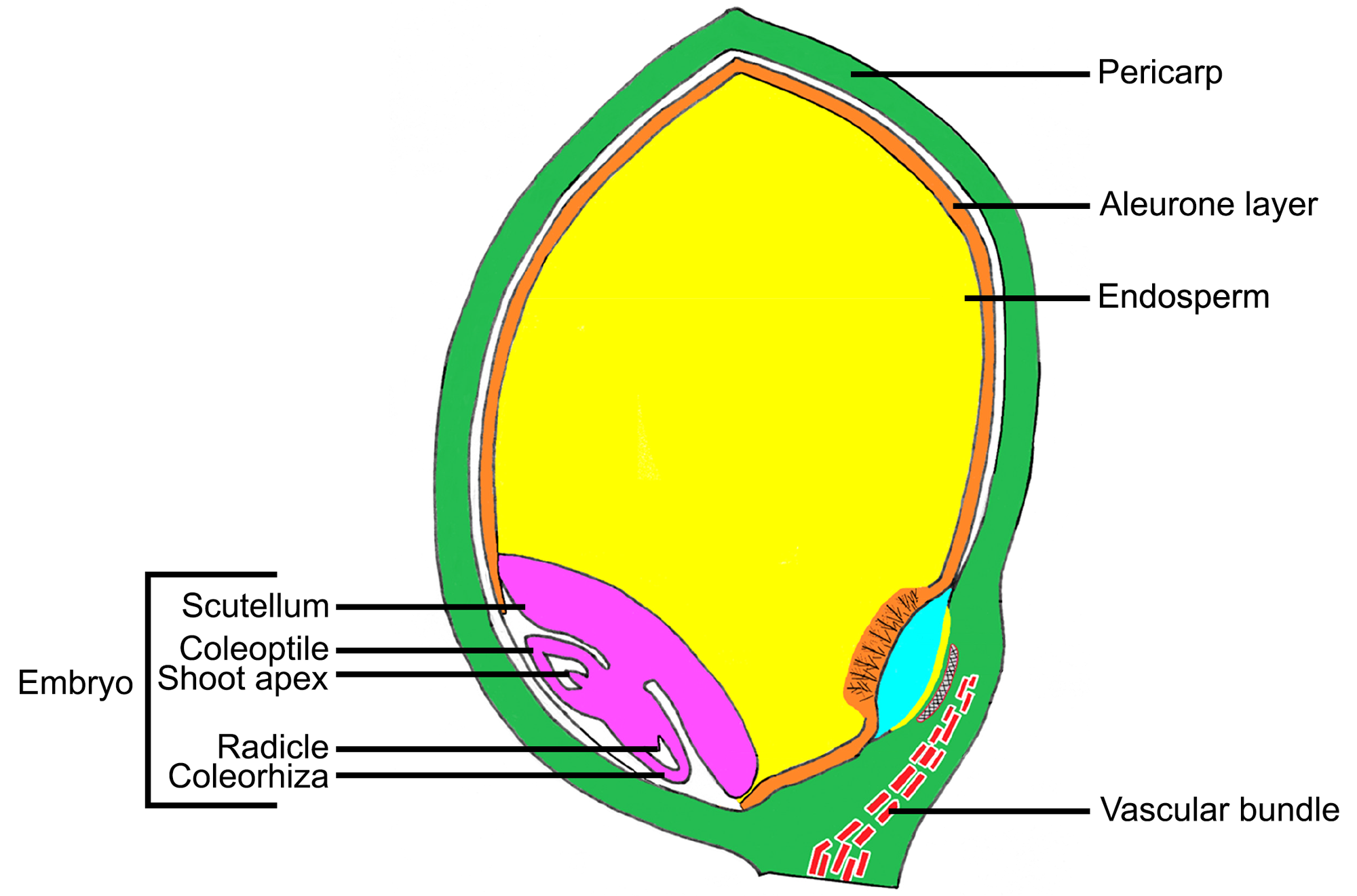
Diagram of a caryopsis (grain) of sorghum (Sorghum bicolor) in longitudinal section, 20 days after flowering. Source: Modified from figure 3 in Shankar and Dayanandan (2020) Notulae Scientia Biologicae 12: 852-868 (Creative Commons Attribution 4.0 International license).
Resources
Websites
Glossary of botanical terms used in Poaceae (Flora of China online): http://flora.huh.harvard.edu/floradata/002/vol22/poaceaeglossary.htm
How a sorghum plant develops (Billy E. Warrick, Professor and Extension Agronomist): http://www.soilcropandmore.info/crops/sorghum/sorghum.htm
Poaceae (Graminae) (University of Hawai'i): http://www.botany.hawaii.edu/faculty/carr/po.htm
Scientific articles and books
Clark, L. G., and E. A. Kellogg. In Flora of North America Editorial Committee, Flora of North America North of Mexico vol. 24. Poaceae. Accessed online at: http://floranorthamerica.org/Poaceae
Kellogg, E. A. 2015. Flowering Plants, Monocots, Poaceae. The Families and Genera of Vascular Plants 13, 416 pp. (K. Kubitzki, ed.). Springer International Publishing, Switzerland. https://doi.org/10.1007/978-3-319-15332-2_1
Lee, K.-W., and R. C. Lammasson. 1968. The epidermis of the blade joint of Sorghum Moench. Proceedings of the Iowa Academy of Science 75: 55-64. https://scholarworks.uni.edu/pias/vol75/iss1/12
Out, W. A., and M. Madella. 2017. Towards improved detection and identification of crop by-products: Morphometric analysis of bilobate leaf phytoliths of Pennisetum glaucum and Sorghum bicolor. Quaternary International 434: 1-14. https://doi.org/10.1016/j.quaint.2015.07.017
Shankar, S. R., and P. Dayanandan. 2020. Structure and histochemistry of sorghum caryopsis in relation to grain filling. Notulae Scientia Biologicae 12: 852-868. https://doi.org/10.15835/nsb12410714
Zancajo, V. M. R., S. Diehn, N. Filiba, G. Goobes, J. Kneipp, and R. Elbaum. 2019. Spectroscopic discrimination of sorghum silica phytoliths. Frontiers in Plant Science 10: 1571. https://doi.org/10.3389/fpls.2019.01571



